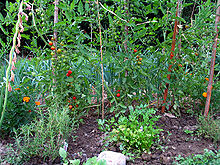Vegetable garden

A vegetable garden is that part of a private kitchen garden that is used to grow vegetables . The fruit and vegetable gardens of monasteries and stately homes were formerly known as kitchen gardens .
Size and yield
If the vegetable garden is to provide complete self-sufficiency with vegetables over the year, it must have a size of 50 to 80 per person to be cared for, or even up to 100 m² per person if there is a high demand for vegetables. A yield of around 2.5 kg of vegetables can be expected per m² of cultivation area. Insofar as the vegetable requirement is not only to be met from your own cultivation, an area of 25 m² per person is considered sufficient.
Cultivation Techniques
In order to ensure crop rotation , it is advisable to divide up the areas under cultivation. The heavy eaters (so-called first costume, e.g. cabbage , chard or pumpkins ), the weak eaters (so-called second costume, e.g. onions , root vegetables or potatoes ) and legumes (as the so-called third costume ) are put on the parts every year ) grown alternately. A farmyard manure is only before the cultivation of strong Zehrern. Under favorable soil conditions, however, a combination of the second and third forage or a pronounced mixed culture can take place. When growing permanent vegetables such as asparagus or rhubarb , another part is required. A division into beds is helpful, but not mandatory. However, sowing or planting is usually done in rows to facilitate hoeing and weeding. In the case of permaculture cultivation, there is preferably no mechanical cultivation of the soil; useful plants are planted or sown in a soil with low vegetation.
Unlike the ornamental garden that is spread soil of the vegetable garden mostly turning in the fall or winter for instance by digging with spades or plows worked to plant residues in the soil bring the tilth to promote and weed growth to slow. However, types of non-turning “gentle” tillage, which simply loosen the soil without changing the layer structure, are also in use. During the cultivation phases, shallow soil cultivation (only 2 to 3 cm deep) with hoes or similar garden tools (such as the hand cultivator ) is used to control weeds, ventilate the topsoil and break the soil capillaries to reduce evaporation.
See also
- Raised bed
- Hill bed
- Cottage garden
- seedbed
- Cold frame
- Deep cultivation bed
- Perennial bed
- Carpet bed
- Herb spiral
- Potato bin
- Gardener construction
literature
- Joachim Breschke: The vegetable garden. Creative planning, planting and care. Stedtfeld Verlag GmbH, Münster 1991, ISBN 3-927624-12-8 .
- Geoff Hamilton: The perfectly healthy garden. The big book for organic gardeners. BLV Verlagsgesellschaft, Munich Vienna Zurich 1989, ISBN 3-405-13490-0 .
- Renate Zeltner: The intensive garden. The ornamental and kitchen garden throughout the year. Verlag Martin Greil GmbH, Grünwald 1990, ISBN 3-89430-103-1 .
Web links
Individual evidence
- ↑ Horst Koehler : The practical garden book, 38th edition . C. Bertelsmann Verlag, Gütersloh 1961, page 401.
- ↑ Winfried Titze: Fresh vegetables from the garden . Ulmer, Stuttgart 1987, ISBN 3-8001-6293-8 , page 39 f.
- ↑ Horst Koehler: The practical garden book, 38th edition . C. Bertelsmann Verlag, Gütersloh 1961, page 402 f.
- ↑ Winfried Titze: Fresh vegetables from the garden . Ulmer, Stuttgart 1987, ISBN 3-8001-6293-8 , page 28.
- ↑ Winfried Titze: Fresh vegetables from the garden . Ulmer, Stuttgart 1987, ISBN 3-8001-6293-8 , page 29 f.
